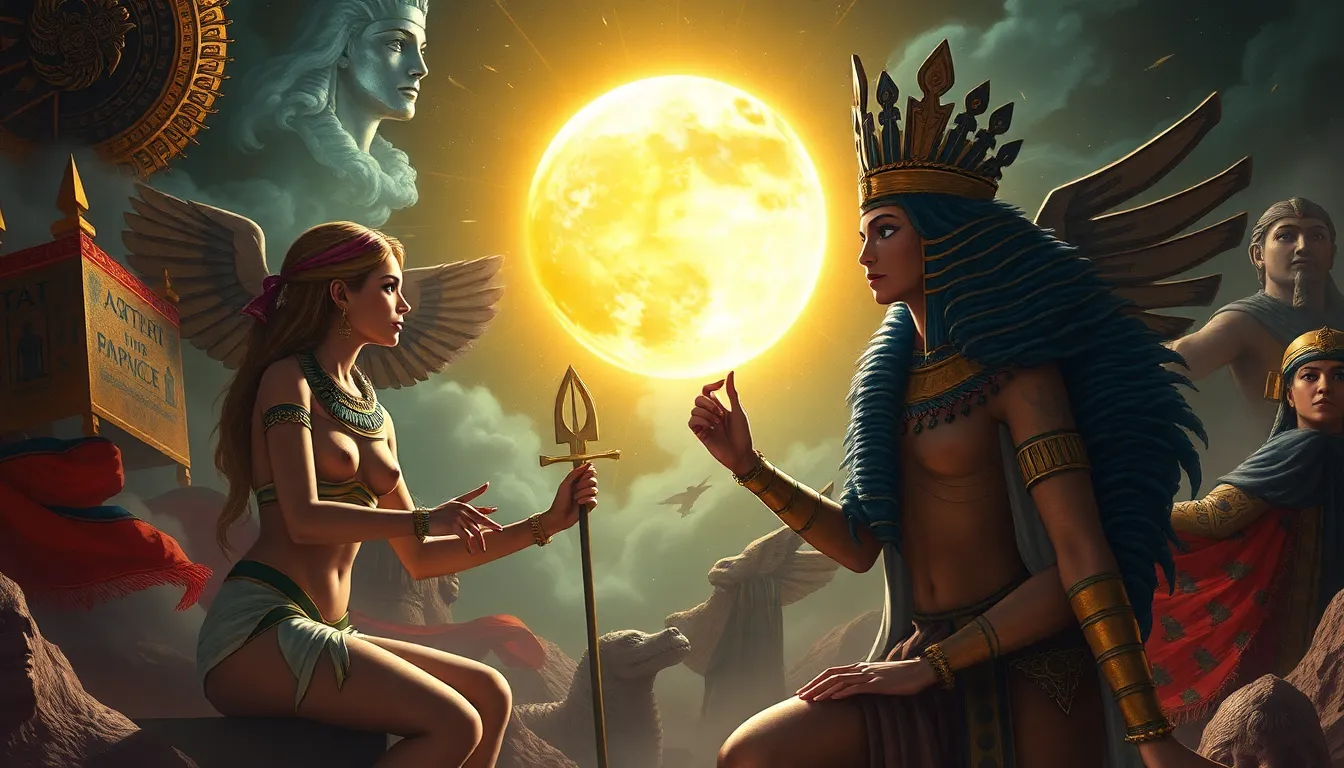The Birth of the Goddesses: Female Deities in Egyptian Mythology
I. Introduction
Egyptian mythology is a rich tapestry of stories, beliefs, and deities that have captivated human imagination for millennia. It offers insight into the ancient Egyptians’ understanding of the universe, humanity, and the divine. Among the myriad of gods and goddesses, female deities hold a special place, embodying various aspects of life, nature, and the cosmos.
This article aims to explore the origins and attributes of major goddesses in Egyptian mythology, emphasizing their significance within the pantheon and their profound impact on ancient Egyptian society.
II. The Creation Myths and the Emergence of Goddesses
Egyptian creation myths tell the story of the universe’s origins, often featuring a mix of chaotic waters, primordial beings, and the birth of gods and goddesses. These myths serve as a foundation for understanding the cosmos in Egyptian thought.
Female deities play crucial roles in these creation narratives. For instance, goddesses such as Nut and Isis are not only creators but also nurturers, representing life-giving forces that are essential to the continuation of existence.
The significance of gender in Egyptian cosmology is profound; the presence of powerful female figures challenges traditional notions of masculinity in deity representation. Goddesses often embody both nurturing and fierce aspects, signifying the duality of creation and destruction.
III. Major Goddesses and Their Birth Stories
A. Isis: The Mother and Protector
1. Origins and birth narrative
Isis, one of the most venerated goddesses in Egyptian mythology, is often referred to as the mother of all. Her birth narrative is intertwined with the story of Osiris, her brother and husband, whose death and resurrection she famously orchestrated.
2. Key attributes and symbols
- Motherhood and fertility
- Magic and healing
- Symbolized by the throne, ankh, and the scorpion
B. Hathor: The Goddess of Love and Joy
1. Birth and cultural significance
Hathor is often associated with joy, music, and motherhood. Born from the sun god Ra, she is celebrated as a nurturing figure who brings happiness and love to both gods and mortals.
2. Her roles in society and mythology
- Goddess of music, dance, and fertility
- Patroness of women and childbirth
- Symbol of the cow, representing abundance and nourishment
C. Nut: The Sky Goddess
1. The story of her birth and cosmic role
Nut, the sky goddess, embodies the heavens and is often depicted arching over the earth goddess Geb. According to myth, she was born from the primordial waters and was responsible for enveloping the earth.
2. Depictions in art and literature
Nut is commonly depicted as a woman with a starry body, showcasing her connection to the cosmos. Artistic representations often show her swallowing the sun at dusk and giving birth to it at dawn, a powerful symbol of renewal.
IV. The Interconnections Among Goddesses
The relationships between female deities in Egyptian mythology are intricate and significant. Many goddesses are part of larger familial structures that highlight the importance of sisterhood and motherhood.
- Isis and Nephthys are sisters, both playing vital roles in the Osiris myth.
- Hathor and Isis often collaborate in rituals, emphasizing their interconnectedness.
These familial ties underscore the collaborative nature of female deities in myths and rituals, reinforcing the idea that the divine feminine is a powerful force within Egyptian cosmology.
V. The Influence of Goddesses on Egyptian Society
Female deities were central to religious practices and societal norms in ancient Egypt. Worship and rituals dedicated to goddesses like Isis and Hathor were widespread, reflecting their importance in daily life.
- Rituals often involved music, dance, and offerings to honor these goddesses.
- Goddesses were invoked for protection, fertility, and guidance in governance.
Female deities served as symbols of power and fertility, influencing various aspects of Egyptian culture, from agriculture to social norms.
VI. The Evolution of Female Deities Over Time
As Egyptian society evolved, so did the perception of its goddesses. Historical changes, such as the influence of foreign cultures, led to the syncretism of deities, where attributes of goddesses blended with those from other religions.
Modern interpretations of these goddesses have seen a resurgence of interest, particularly in the context of feminism and spirituality. Many contemporary spiritual practices draw on the rich symbolism and narratives of Egyptian goddesses, emphasizing their relevance in today’s world.
VII. The Legacy of Egyptian Goddesses in Contemporary Culture
The influence of Egyptian goddesses extends beyond ancient times, permeating literature, art, and modern media. They are often portrayed as powerful figures embodying strength, wisdom, and compassion.
- In literature, goddesses are frequently reimagined in contemporary narratives.
- Artistic interpretations showcase their timeless beauty and power.
- The resurgence of interest in goddess spirituality aligns with contemporary feminist movements, emphasizing empowerment and self-discovery.
The archetypes of these goddesses continue to resonate, inspiring new generations to explore the depths of their stories and attributes.
VIII. Conclusion
Female deities in Egyptian mythology are of paramount importance, serving as symbols of creation, protection, and nurturing. Their stories and attributes reflect the complex relationship between gender and divinity in ancient Egyptian culture.
The enduring legacy of these goddesses in human consciousness invites us to further explore ancient mythologies and their impacts on contemporary life, reminding us of the timeless power of the divine feminine.




